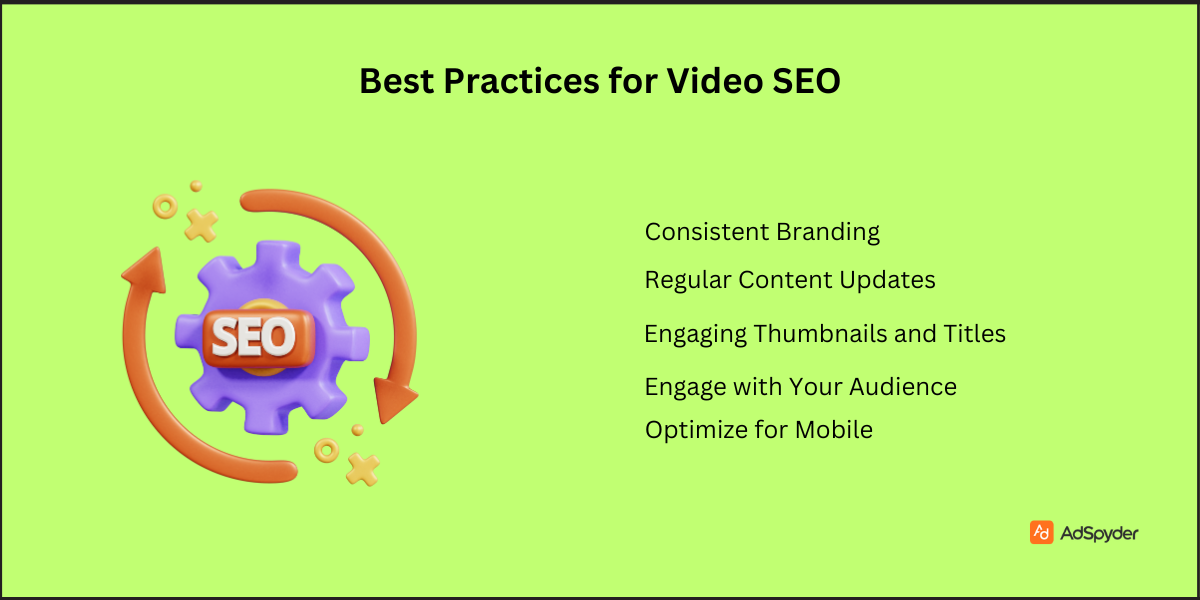Video marketing has become a cornerstone of modern digital marketing strategies. As the consumption of video content continues to rise, optimizing videos for search engines is crucial for ensuring visibility and engagement. SEO for video marketing involves various techniques, from keyword research to optimizing metadata and video descriptions. This blog explores effective SEO strategies for video marketing, offering actionable insights to help your videos rank higher and reach a broader audience.
Ready to Elevate your Marketing Strategy?
Summary
This blog covers:
- The importance of SEO Strategies for video marketing.
- Keyword research and optimization for videos.
- Optimizing video metadata and descriptions.
- Strategies for increasing video visibility on search engines.
- Best practices for video SEO.
- A detailed FAQ section addressing common questions about video SEO.
By the end of this blog, you will have a comprehensive understanding of how to optimize your video content for search engines, enhancing your visibility and engagement.
The Importance of SEO Strategies for Video Marketing
Increased Visibility
Optimizing your videos for search engines increases their chances of being discovered by a broader audience. With proper SEO, your videos can appear on search engine results pages (SERPs), video platforms, and even social media feeds, driving more traffic to your content. Videos that rank well in search results are more likely to attract organic views, leading to sustained growth over time.
Enhanced User Experience
SEO for video marketing isn’t just about search engines; it’s also about providing a better user experience. Optimized videos are easier to find and more likely to be relevant to the user’s search intent, leading to higher engagement and satisfaction. Users are more likely to stay on your page and watch your videos if they find the content relevant and valuable, which can reduce bounce rates and increase dwell time on your website.
Higher Engagement and Conversions
Videos that rank well are more likely to be viewed, shared, and engaged with. This increased visibility can lead to higher engagement rates, more social shares, and ultimately, higher conversion rates. By optimizing your videos, you ensure they reach the right audience at the right time, guiding them through the customer journey from awareness to decision-making.
Building Brand Authority of SEO Strategies for Video Marketing
Consistently producing high-quality, optimized video content can establish your brand as an authority in your industry. When users frequently encounter your videos in search results, it reinforces your brand’s presence and credibility. Over time, this can lead to increased trust and loyalty among your audience, positioning your brand as a go-to source for information and solutions.
Keyword Research and Optimization for SEO Strategies for Video Marketing

Identifying Relevant Keywords:
Keyword research is the foundation of video SEO. Start by identifying keywords and phrases that your target audience is likely to use when searching for content related to your video. Tools like Google Keyword Planner, Ahrefs, and SEMrush can help you discover high-traffic keywords. Consider user intent behind the keywords—are they looking for how-to guides, product reviews, or entertainment?
Long-Tail Keywords:
Long-tail keywords are specific phrases that often have lower search volumes but higher intent. They can help you target a niche audience more effectively. For example, instead of targeting “video marketing,” you might target “video marketing tips for small businesses.” Long-tail keywords are typically less competitive, making it easier to rank higher in search results.
Using Keywords in Video Titles:
Incorporate your primary keywords into the video title. The title is one of the first elements search engines and users see, so it should be clear, compelling, and relevant. Ensure your keywords fit naturally within the title to avoid keyword stuffing. A well-crafted title not only helps with SEO but also encourages users to click and watch your video.
Keyword Placement in Video Content:
While keywords in titles and descriptions are important, mentioning them naturally in the video content can also be beneficial. Search engines are getting better at understanding audio content within videos, and using relevant keywords in your script can provide additional context and relevance.
Optimizing Video Metadata and Descriptions
Video Descriptions:
A well-written video description provides context for both search engines and viewers. Include your primary keywords in the description, but ensure it reads naturally and provides value. Descriptions should be detailed, informative, and at least 200 words long to give search engines enough content to understand the video’s context. Describe the main points covered in the video, and include links to related content or additional resources.
Tags and Categories:
Use relevant tags and categories to help search engines understand the content of your video. Tags should include primary and secondary keywords, as well as related terms. Categories should accurately reflect the content and purpose of your video. Properly categorized videos are more likely to be recommended to users who are interested in similar topics.
Thumbnails of SEO Strategies for Video Marketing
While not directly related to SEO, an engaging thumbnail can improve click-through rates. A higher click-through rate can signal to search engines that your video is valuable and relevant, indirectly boosting your rankings. Create custom thumbnails that are visually appealing and accurately represent the content of the video. Use bright colors, readable text, and compelling images to attract clicks.
Optimizing Video File Names:
Before uploading your video, ensure that the file name includes relevant keywords. Instead of using a generic file name like “video123.mp4,” use a descriptive name like “video-marketing-tips-small-businesses.mp4.” This small step can provide an additional SEO boost.
Strategies for Increasing Video Visibility on Search Engines

Embedding Videos on Your Website:
Embedding videos on your website can enhance your site’s SEO. Ensure the video is embedded on a relevant page and surrounded by keyword-rich text. This context helps search engines understand the video’s relevance and boosts its chances of ranking. Additionally, embedding videos can increase the time visitors spend on your page, which is a positive signal to search engines.
Video Sitemaps:
Create and submit a video sitemap to help search engines index your videos. A video sitemap provides search engines with metadata about your videos, including title, description, duration, and more. This can improve your video’s visibility in search results. Regularly update your video sitemap as you add new content to ensure all your videos are indexed.
Transcriptions and Closed Captions:
Adding transcriptions and closed captions to your videos can improve SEO. Transcriptions provide additional text for search engines to crawl, increasing the chances of your video appearing in search results. Closed captions make your videos accessible to a wider audience, including those with hearing impairments or who speak different languages. They also enhance the user experience for viewers who prefer watching videos without sound.
Backlinks and Social Shares:
Encourage backlinks and social shares to increase your video’s authority and visibility. Share your videos across social media platforms, embed them in blog posts, and reach out to influencers and bloggers to promote your content. The more your video is shared and linked to, the higher its chances of ranking well. Building a network of high-quality backlinks can significantly boost your video’s SEO performance. Also used paid media to boost your video visibility using LinkedIn ads, YouTube ads etc, to make sure it starts off with a significant engagement.
Leveraging YouTube’s Features:
If you’re using YouTube as your video hosting platform, take advantage of its built-in features to improve SEO. Use end screens and cards to promote other videos, playlists, or your website. Engage with viewers in the comments section to foster community and encourage more interaction. Use YouTube’s analytics to track performance and identify areas for improvement.
Best Practices for Video SEO

Consistent Branding:
Maintain consistent branding across all your videos. Use similar styles, logos, and color schemes to create a cohesive brand identity. Consistent branding helps viewers recognize your content and builds trust and loyalty. This recognition can lead to increased click-through rates and viewership over time.
Regular Content Updates:
Regularly update your video content to keep it fresh and relevant. This can involve adding new videos, updating old ones, or repurposing existing content. Consistently publishing new content signals to search engines that your site is active and valuable. Consider creating a content calendar to plan and schedule your video releases.
Engaging Thumbnails and Titles:
Create engaging thumbnails and titles that capture attention and encourage clicks. Use high-quality images, bold text, and clear, compelling language. Your thumbnails and titles are the first things viewers see, so make sure they stand out. A/B tests different thumbnails and titles to see which ones perform better and optimize accordingly.
Analyze and Adjust:
Regularly analyze your video’s performance and adjust your strategy as needed. Use analytics tools to track key metrics such as views, engagement, click-through rates, and conversions. This data will help you understand what’s working and what needs improvement. Make data-driven decisions to continuously refine your video SEO strategy.
Create Playlists:
Organize your videos into playlists based on themes or topics. Playlists not only help users find related content but also increase the total watch time on your channel, which can positively impact your SEO. Use descriptive titles and descriptions for your playlists, and include relevant keywords.
Engage with Your Audience:
Engage with your viewers by responding to comments and encouraging discussions. Engagement signals to search engines that your content is valuable and relevant. Building a community around your videos can lead to increased loyalty and more shares, further boosting your SEO efforts.
Optimize for Mobile:
Ensure that your videos are optimized for mobile viewing. With a significant portion of video content being consumed on mobile devices, it’s crucial to provide a seamless experience. Use responsive design for your website, create mobile-friendly thumbnails, and ensure your videos load quickly on mobile networks.
FAQs
Video SEO involves optimizing video content to improve its visibility and ranking on search engines. It’s important because it increases the chances of your videos being discovered by a broader audience, leading to higher engagement, traffic, and conversions.
Use tools like Google Keyword Planner, Ahrefs, and SEMrush to identify relevant keywords and phrases that your target audience is likely to use. Focus on long-tail keywords that have lower search volumes but higher intent to effectively target a niche audience.
Write detailed, informative descriptions that include your primary keywords. Ensure the description reads naturally and provides value to viewers. Describe the main points covered in the video and include links to related content or additional resources.
Transcriptions and closed captions provide additional text for search engines to crawl, increasing the chances of your video appearing in search results. They also make your videos accessible to a wider audience, including those with hearing impairments or who speak different languages.
Share your videos across social media platforms, embed them in blog posts, and reach out to influencers and bloggers to promote your content. Encourage viewers to share your videos by creating engaging, valuable content that resonates with your audience.
Track key metrics such as views, engagement, click-through rates, and conversions. Set specific goals and KPIs for your video SEO efforts to measure success and make data-driven decisions.
Conclusion of SEO Strategies for Video Marketing
Recap
Optimizing your videos for search engines is crucial for increasing visibility, engagement, and conversions. By conducting thorough keyword research, optimizing metadata and descriptions, and implementing best practices, you can enhance your video’s SEO and reach a broader audience.
Final Thoughts
Effective video SEO requires a strategic approach and regular analysis. By following the strategies outlined in this blog and continuously refining your efforts, you can improve your video’s performance and achieve your marketing goals. Stay updated with the latest SEO trends and adapt your strategy to maintain a competitive edge.
Call to Action
We encourage you to share your experiences and thoughts on video SEO in the comments. Try implementing these strategies in your video marketing efforts and observe the impact on your visibility and engagement. Your feedback and insights can help others in the community enhance their video SEO strategies.



